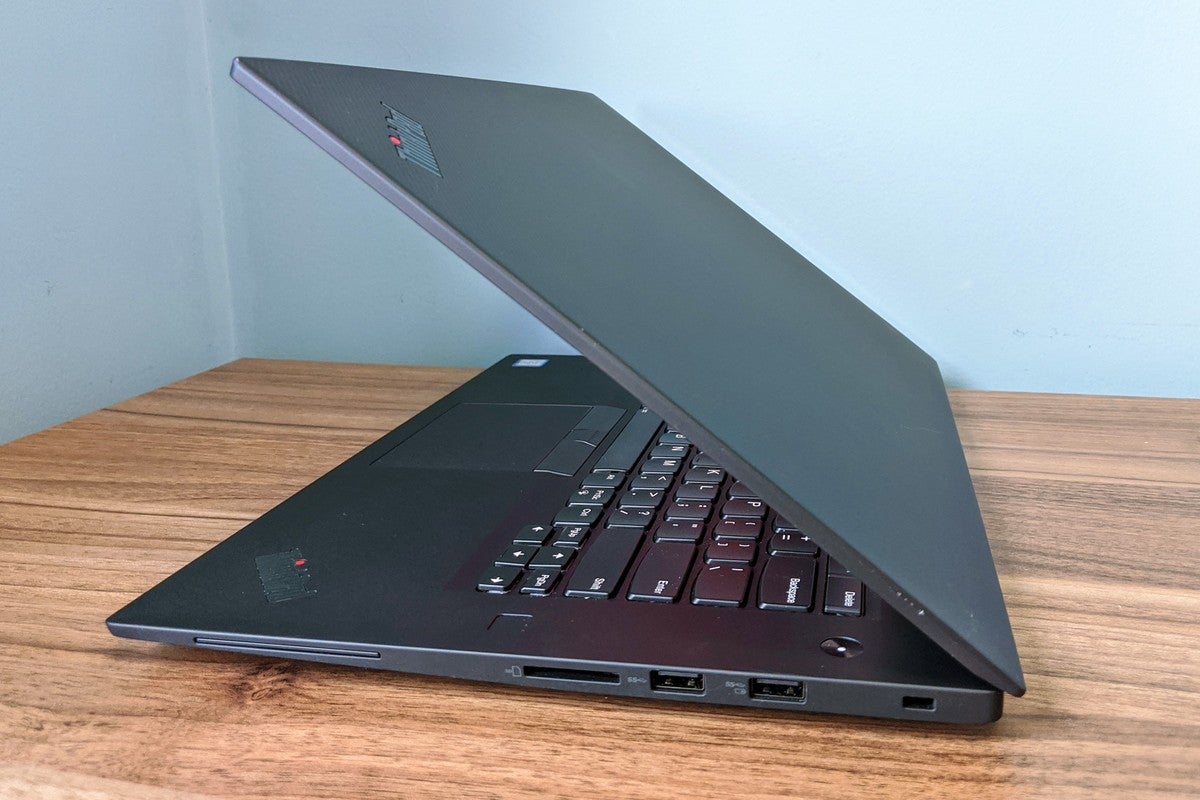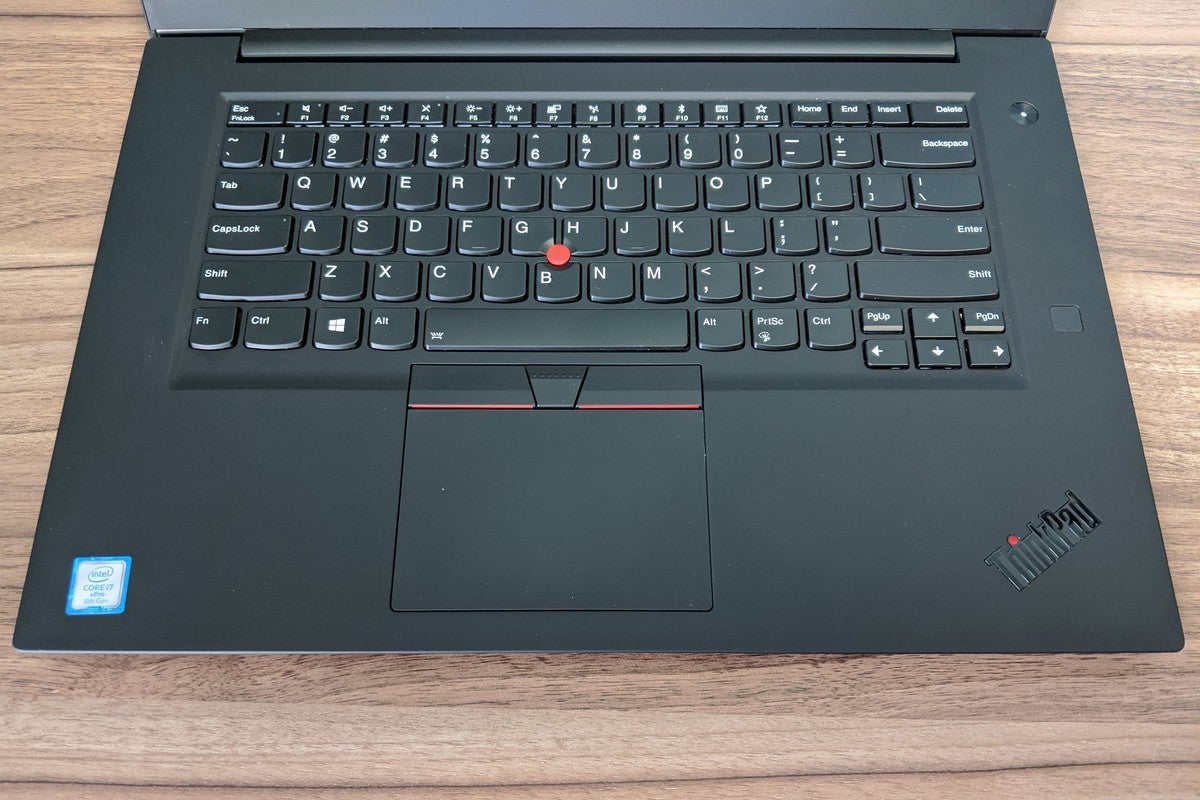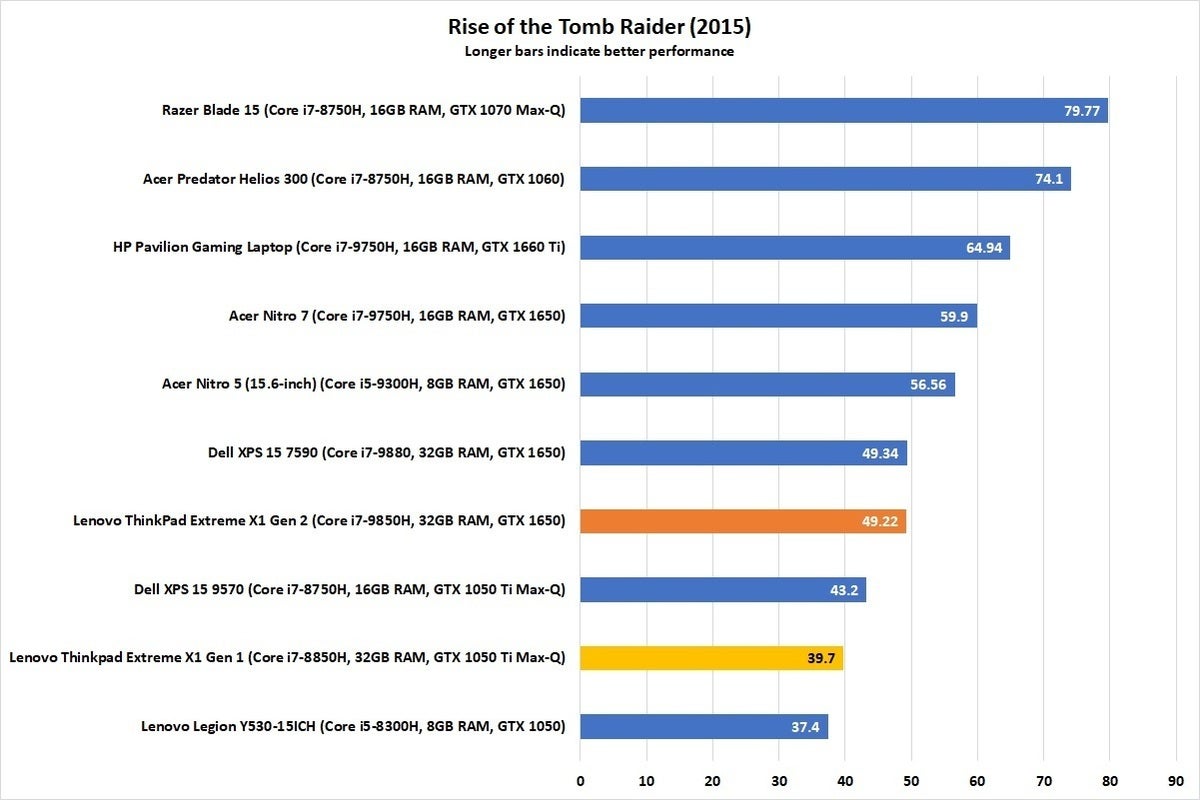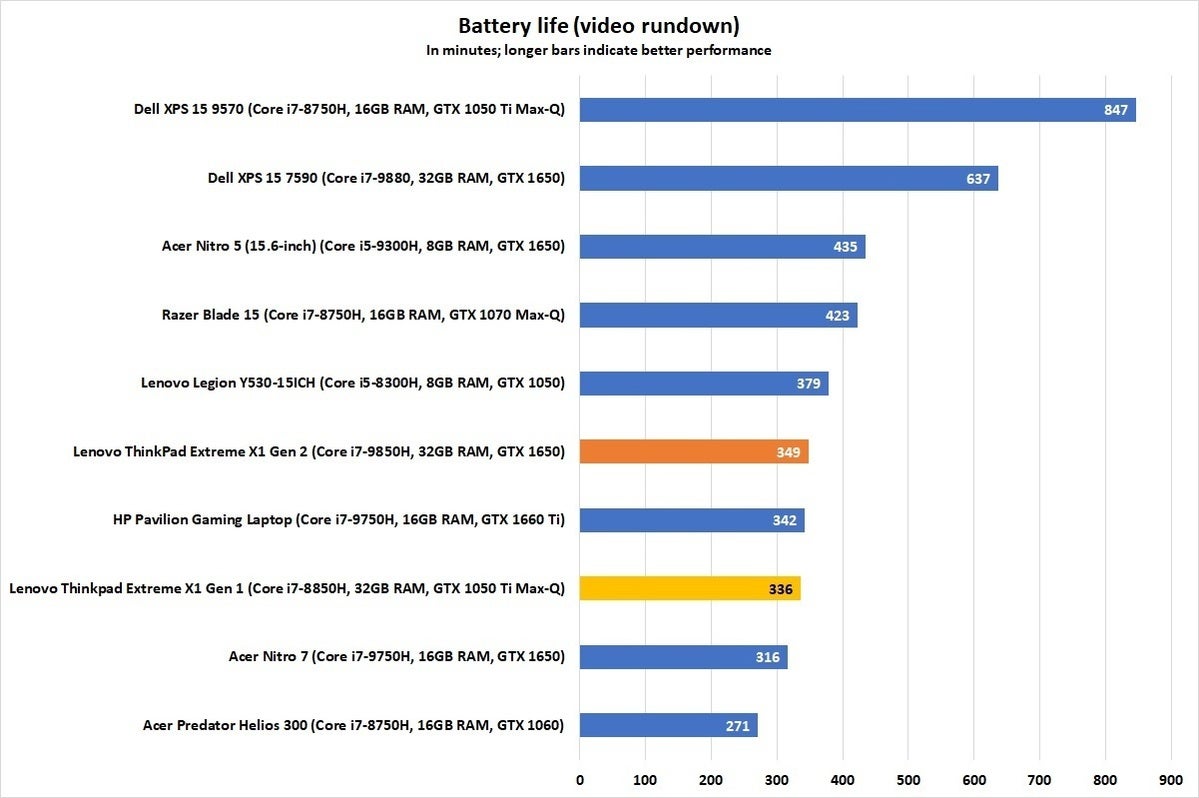 Credit: Jared Newman / IDG
Credit: Jared Newman / IDG
Lenovo’s ThinkPad X1 Extreme Gen 2 is a slick business laptop with the power of a lightweight gaming rig. Behind its buttoned-down facade, you’ll find Nvidia GeForce GTX 1650 graphics and up to a 4K display, all in a laptop weighing well under 4 pounds.
Why buy a laptop like this? Maybe you’re into VR app development, or you’d like to take advantage of certain applications that make use of GPU acceleration, from Adobe’s After Effects and Premiere Pro to 3D modeling and big data software. Or perhaps you just want to spend some time with the Yakuza series or The Outer Worlds on your ThinkPad once the workday is done.
No judgment here either way, but if your priority is portability, you’ll likely want to look elsewhere, or at least avoid the 4K model we tested. Considering the weak battery life, the graphical demands of 4K resolution, and an unusual default screen brightness setting that we’ll explain later, the Lenovo ThinkPad X1 Extreme Gen 2 is a laptop that works best on outlet power despite its light weight. That way, it can still make full-time use of its discrete graphics card.
Tech specs
The Lenovo ThinkPad X1 Extreme Gen 2 comes in many potential configurations, with some high-end features (such as the vPro-equipped CPU, and Windows 10 Pro OS) you see only on corporate laptops. Our particular review unit, which costs $2,844 at CDW, includes the following:
- CPU: 9th-generation Intel Core i7-9850H processor with vPro (2.6GHz, up to 4.6GHz with Turbo Boost, 6 Cores, 12MB Cache)
- GPU: Nvidia GeForce GTX 1650 graphics
- RAM: 32GB DDR4 2666MHz (2 x 16GB)
- Storage: 1TB PCIe SSD
- Display: 15.6-inch, 3840x2160 resolution IPS display with Dolby Vision HDR
- Video: 720p webcam with infrared for Windows Hello
- Authentication: Fingerprint reader
- Operating system: Windows 10 Pro
- Left side: Two USB-C 3.1 Thunderbolt ports, HDMI port, DisplayPort, headphone jack, proprietary charger
- Right side: Two USB-A 3.0 ports, SD card reader, lock slot
- Weight: 3.75 pounds (4.6 pounds with charger)
- Dimensions: 14.2 x 9.7 x 0.7 inches
 Jared Newman / IDG
Jared Newman / IDG
Port selection includes two USB-C, HDMI, DisplayPort, and 3.5mm audio on the left side, plus two USB-A 3.0 and an SD card slot on the right.
Granted, Lenovo’s minimum configuration costs a lot less. Sticking to an Intel Core i5-9300H processor, 1080p display with 300 nits' brightness, 8GB of RAM, a 256GB solid state drive, and Windows 10 Home brings the price to $1,721 on Lenovo’s website. You can also max out with 64GB of RAM and a 4K OLED display for $3,502. But in all cases, that GTX 1650 graphics card remains constant.
Design and display
Like the original ThinkPad X1 Extreme, which had Nvidia GeForce GTX 1050 Ti Max-Q graphics, the second-gen version touts lightness as a key selling point, though it now has a more powerful graphics card inside. At 3.75 pounds, it’s more than a half-pound lighter than Apple’s 16-inch MacBook Pro and 0.35 pounds lighter than Dell’x XPS 15 7590. The combination of light weight and decent graphics might help explain the “Extreme” moniker.
That said, the ThinkPad X1 Extreme Gen 2 looks about as businesslike as other ThinkPads, with an all-black finish and red accents via the ThinkPad logo and TrackPoint nub. To make it a little fancier, you can opt for a carbon fiber weave on the laptop’s lid.
This is not a touchscreen laptop, but the display tilts back 180 degrees in case you want to prop it up at eye level and use an external keyboard and mouse. And while it’s not a thin-and-light laptop, its narrow display bezels keep things reasonably trim, measuring 0.34 inches on the left and right edges and 0.5 inches on top.
 Jared Newman / IDG
Jared Newman / IDG
The ThinkPad X1 Extreme Gen 2 cuts a pretty slim figure despite the discrete GPU inside.
As for the display itself, the 4K LCD we tested has a matte finish and is brilliant, if a bit oversaturated out of the box. We measured a maximum display brightness of 442 nits, versus Lenovo’s claim of 500 nits, but that’s still far brighter than any gaming or workhorse laptop we’ve tested recently. The display also supports Dolby Vision HDR, so the colors can really pop if you’re watching supported videos on Netflix or YouTube.
The display does have one notable quirk, however: To encourage better battery life, Lenovo aggressively scales down the brightness level at anything less than 100 percent by default, so pressing the keyboard’s brightness down button even once causes a significant drop-off. You can use Windows’ software slider for finer adjustments, but that’s more of a hassle and still leaves you without much precision at higher brightness levels.
To override this behavior, you must restart the computer and enter Lenovo’s BIOS settings to change the graphics mode from “Hybrid” to “Discrete” under Config > Display. Doing so makes the brightness controls more linear, but it also disables Intel’s integrated graphics, which the laptop uses to conserve battery life under light workloads. That brings some trade-offs we’ll discuss in the Performance section below.
 Jared Newman / IDG
Jared Newman / IDG
To get more even brightness adjustments, you’ll have to take a trip to the BIOS.
Keyboard and trackpad
The keyboard on the X1 Extreme Gen 2 is standard-issue for a ThinkPad, so you’ll get shield-shaped keys with a generous amount of travel. They’re pretty rigid, which can take some getting used to, but they allow for fast, accurate typing once you get rolling. In a typing test, I averaged 107 words per minute, on a par with my rate using my desktop mechanical keyboard. (Like other ThinkPads, this one bucks Windows convention by flipping the Function and Left Control keys, but you can switch them through Lenovo’s BIOS settings.)
 Jared Newman / IDG
Jared Newman / IDG
If you’ve seen a ThinkPad before, this’ll all look familiar.
The trackpad follows ThinkPad convention as well, with dedicated right- and left-click buttons flanking a middle button that, when held, lets you scroll using the TrackPoint nub. While the trackpad is smooth to the touch, clicking on it takes some effort, especially as your finger moves higher up. The trackpad surface is also narrow for a 15-inch laptop, measuring a little under 4 inches across.
Camera, sound, and security
Given the ThinkPad X1 Extreme Gen 2’s display chops and graphics power, it’s too bad it can’t keep up on audio quality. Sound comes from a pair of downward-facing speakers underneath the front portion of the laptop. The lack of high-end clarity gives them a muffled sound.
Webcam quality is similarly lackluster at 720p, but it does have an option for an infrared sensor so you can unlock the laptop with iris scanning. This feature can sometimes be hit-or-miss on other laptops, but it was rock-solid on the X1 Extreme Gen 2, even in less-than-ideal lighting conditions. A fingerprint reader also comes standard, providing a handy fallback for those rare occasions when iris scanning doesn’t register.
In a nice touch, Lenovo included a physical shutter switch for the webcam, so you no longer have to gunk up the camera lens with tape in moments of paranoia. Just bear in mind that this prevents face unlock from working, and Windows won’t understand why. Instead, it’ll keep looking for your face until you realize the issue yourself.
 Jared Newman / IDG
Jared Newman / IDG
A red dot on the camera lens lets you know the privacy slider is shut.
Performance
The X1 Extreme Gen 2's distinctive feature compared to other ThinkPads is its Nvidia GeForce GTX 1650 graphics card, which provides a lot more muscle for games and certain 3D-accelerated applications.
Whether you can enjoy that component to its fullest potential depends on one important setting. By default, the ThinkPad X1 Extreme Gen 2 is set to a “Hybrid” graphics mode that can switch off the GPU when the system doesn’t need it. As we’ve seen on other laptops, however, integrated graphics just doesn’t cut it for 4K displays. In Hybrid mode, the ThinkPad would sometimes exhibit choppy scrolling in certain applications. Switching to “Best Performance” in Windows’ power management settings didn’t help, even with the laptop plugged in.
The ThinkPad X1 Extreme Gen 2 also ships with drivers that don’t always seem to detect when the GPU should kick in on Hybrid mode. Our graphics benchmarks suffered drastically as a result until we updated the laptop’s BIOS, CPU, and GPU drivers. Even then, the test results in Hybrid mode turned out to be middling.
All of which adds up to a strong case for leaving Discrete mode enabled full-time. Yes, battery life will take a hit, but this is more of a desktop replacement laptop anyway, and the benefits of smoother performance and more linear brightness controls outweigh the drawbacks.
As for how that graphics card performs, the ThinkPad X1 Extreme Gen 2 is still on the low end among workhorse and entry-level gaming laptops. While it’ll handle Fortnite or Destiny 2 without issue, you’ll have to tweak settings downward in some more demanding games to hit a steady 60 frames per second, and you’ll want to stick with 1080p instead of 4K in all cases. As you can see in Rise of The Tomb Raider, the laptop (in Hybrid mode) fell well short of 60 frames per second in benchmarks, though it does show a big bump over the first-generation model.
In all the charts that follow, the ThinkPad X1 Extreme Gen2 is tested in the default Hybrid mode (with updates as noted above) and shown in orange. Its predecessor, the Gen1, is shown in yellow.
 Melissa Riofrio/IDG
Melissa Riofrio/IDG
The Nvidia GeForce GTX 1650 can’t get to 60 frames per second in Rise of The Tomb Raider’s benchmark utility. The ThinkPad X1 Extreme Gen2 is shown in orange above, while its predecessor, the Gen1, is shown in yellow.
Graphics testing in 3DMark Time Spy yielded similar results, with the ThinkPad X1 Extreme Gen 2 landing near the bottom of the pack. Note that other laptops with GTX 1650 fared better, especially those less concerned with slimming down to business-laptop size, such as Acer’s Nitro 7.
 Melissa Riofrio/IDG
Melissa Riofrio/IDG
Even against other laptops with GTX 1650 graphics, the ThinkPad can’t keep up. The ThinkPad X1 Extreme Gen2 is shown in orange above, while its predecessor, the Gen1, is shown in yellow.
That same separation carried over to 3DMark’s Fire Strike Extreme benchmark as well.
 Melissa Riofrio/IDG
Melissa Riofrio/IDG
The ThinkPad is only a little closer to the competition in Fire Strike Extreme. The ThinkPad X1 Extreme Gen2 is shown in orange above, while its predecessor, the Gen1, is shown in yellow.
As for CPU performance, the ThinkPad X1 Extreme Gen 2 was higher up the charts, but not as high as you might expect given its Intel Core i7-9850H processor. In Cinebench, which tests how well the CPU handles bursts of performance, a few laptops with 8th-generation CPUs performed better, including the Gen 1 version of the ThinkPad X1 Extreme.
 Melissa Riofrio/IDG
Melissa Riofrio/IDG
The ThinkPad X1 Extreme Gen 2’s upgrades seem to have an adverse impact on CPU performance, as the Gen 1 scored higher in Cinebench. The ThinkPad X1 Extreme Gen2 is shown in orange above, while its predecessor, the Gen1, is shown in yellow.
The ThinkPad X1 Extreme Gen 2 also fell behind its Gen 1 predecessor in HandBrake, which checks sustained performance by encoding a large video file. Keep in mind, though, that the difference in encoding time was less than a minute.
 Melissa Riofrio/IDG
Melissa Riofrio/IDG
Those performance setbacks carry over to the sustained load of HandBrake, with the Gen 1 ThinkPad encoding a wee bit faster. The ThinkPad X1 Extreme Gen2 is shown in orange above, while its predecessor, the Gen1, is shown in yellow.
As mentioned atop this review, battery life is disappointing. In our video rundown test, which runs at a consistent brightness of around 255 nits on all laptops, the ThinkPad X1 Extreme Gen 2 lasted for 5 hours and 36 minutes, behind most laptops in the gaming and workhorse categories.
 Melissa Riofrio/IDG
Melissa Riofrio/IDG
With a 4K display, discrete graphics, and thin-and-light design, something had to give, and that’s battery life. The ThinkPad X1 Extreme Gen2 is shown in orange above, while its predecessor, the Gen1, is shown in yellow.
Keep in mind we ran this test using the ThinkPad X1 Extreme Gen 2’s “Hybrid” graphics setting. Switching to the “Discrete” mode, which runs the GPU full-time, cut battery life roughly in half. In many cases that might be an acceptable trade-off.
If all this decision-making seems like too much to deal with, Dell’s XPS 15 7590 is the closest alternative. Its priciest configuration (listing at $2,700) packs the same Nvidia GeForce GTX 1650 graphics card, a more powerful Intel Core i9-9980HK processor, and a 4K OLED display. As you can see above, it also did much better in benchmark tests and lasted much longer on battery power.
Still, the ThinkPad 1 Extreme Gen 2 is lighter and comes with more of Lenovo’s business trimmings, such as iris scanning and the iconic TrackPad keyboard. It also just looks more the part of a business laptop.
In other words, the Lenovo ThinkPad X1 Extreme Gen 2 might not be the best performer, but it stands the best chance of hiding your gaming habits from the office.
















